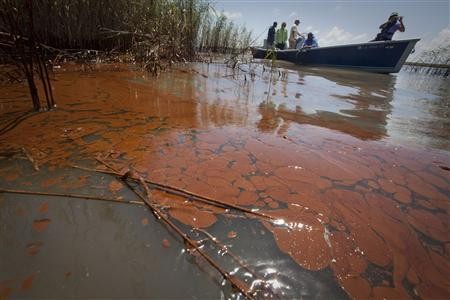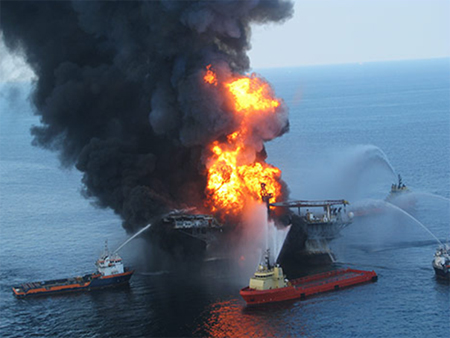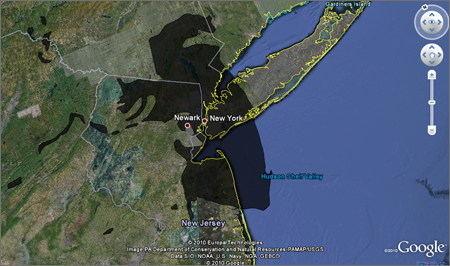This is part 1 of a three-part series on the BP oil spill in the Gulf of Mexico. Part 1 focuses on the history and scale of the spill and how it could impact local residents for years to come. Part 2 focuses on its impacts to birds and wildlife, and part 3 focuses on the future of oil and how to prevent such disasters from happening again.

Oil slick spills into vital wetland habitat in Louisiana
Credit: Reuters
As many of you probably know by now the BP oil spill off the coast of Louisiana has been continuously spewing oil into the Gulf of Mexico for over a month now. Estimates vary as to how much oil is leaking each day – original estimates by the National Oceanic Atmospheric Administration (which was at the time affirmed by BP) put the total leakage at 5,000 barrels per day, however this figure is increasingly looking far too small. Just yesterday the Washington Post argued it could be as high as 95,000 barrels (roughly 4 million gallons) per day, which would dramatically increase estimates as to how much oil has been spilled so far. When BP recently stated they were able to siphon away 5,000 gallons per day but only a fraction of the total spillage, it seems clear the figure is likely very high.
Here’s a video released by BP showing the oil spewing out of the broken pipe on YouTube:
Whatever the exact numbers are, we can be certain of one thing: this oil spill will have long lasting detrimental impacts to the region, both in terms of terms of loss of wildlife as well as lasting impacts on various industries vital to the area such as fishing and tourism.
Ideas on how to reduce the flow of oil have ranged from siphons to plugs, but none have seemed to work effectively. This is in part because this particular leak is at a depth of about 5,000 feet where only small submersibles with robots can work. Many fear that if efforts to reduce the leakage continue to be unsuccessful, it could turn out to be the worst oil spill in history.
BP has even tried spraying chemical dispersants and rounding up and burning condensed areas of spilled oil. But the dispersants have been found to contain harmful chemicals themselves and the selective burns have been ineffective. Despite having over two decades to research better spill prevention and clean-up strategies since the 1989 Exxon-Valdez spill in Alaska, we seemingly keep finding ourselves back at square one.

Explosion at the offshore rig off the coast of Louisiana
Credit: US Coast Guard
The BP oil spill on April 20th began in tragedy. Ironically occurring two days before Earth Day, the explosion on the offshore rig killed 11 workers and left the traumatic experience scarred into the minds of the survivors forever. Shortly after the explosion it was soon realized that the explosion itself was only the beginning of what would become an environmental tragedy. Perhaps the most depressing component of this story (other than the direct loss of life) is that for around $500,000 an emergency shutoff valve could have been installed that would have likely prevented this entire scenario from occurring. Such valves are required in countries like Norway and Brazil, but are not currently in the United States. I will not pretend to be an expert in oil leases and regulation, but such requirements appear to be a no-brainer given the catastrophic consequences of having no backup plan.
By May 1st oil from the spill had begun to hit the Louisiana coastline. Varying sea conditions and currents affected the areas worst impacted on a day to day basis, but one thing became certain: it’s wasn’t going away any time soon. By May 15th the oil slick stretched over an area of 2,500 square miles (roughly the size of Delaware), and this number has not gone down since. Louisiana Governer Bobby Jindal, who toured some of the oiled coastline, reported massive stretches of coastline impacted by the spill.
Louisiana had gone at lengths in recent years to reduce and the loss of and restore vital wetlands habitat, but much of these efforts now seem tarnished.

Blogger Paul Rademacher drew the extent of the oil spill (as of May 13th) in Google Earth and figured out a way to overlay it over some major cities. Above is New York City but you can click on several other major cities or even type in your hometown.
Go to his page >
In addition to the numerous wildlife species affected by the spill, local economies are sure to also take a large hit. The fishing industry in Louisiana alone amounts to $2.5 billion per year and supplies the US with 75% of its domestic shrimp intake, putting the industry is in serious jeopardy. Already nearly one-fifth of the Gulf of Mexico is listed as “off-limits” for fishing, and depending on how quickly they can reduce the flow oil this could rise even higher. Many fishermen are already taking BP to court for lost wages.
Another key industry to the entire region, tourism, is bound to take a hit. The $100 billion industry is slowly seeing reductions in tourists, however only time will tell how many people avoid the region as a result of the oil spill.
The Boston Globe has put together a remarkable series of images from the spill and surrounding areas. If you’re like me and visuals help put the issue into context I highly recommend checking them out – it really helps it hit home:
Photo gallery >
The next oil spill update will be focuses more specifically on the birds and wildlife who call the region home, and how the oil spill is and will continue to affect their everyday lives.

